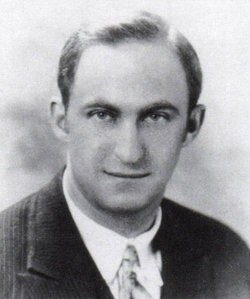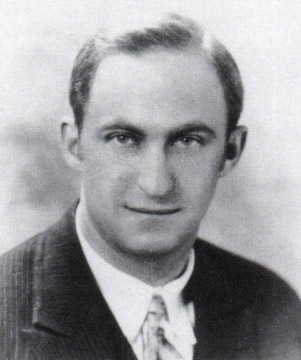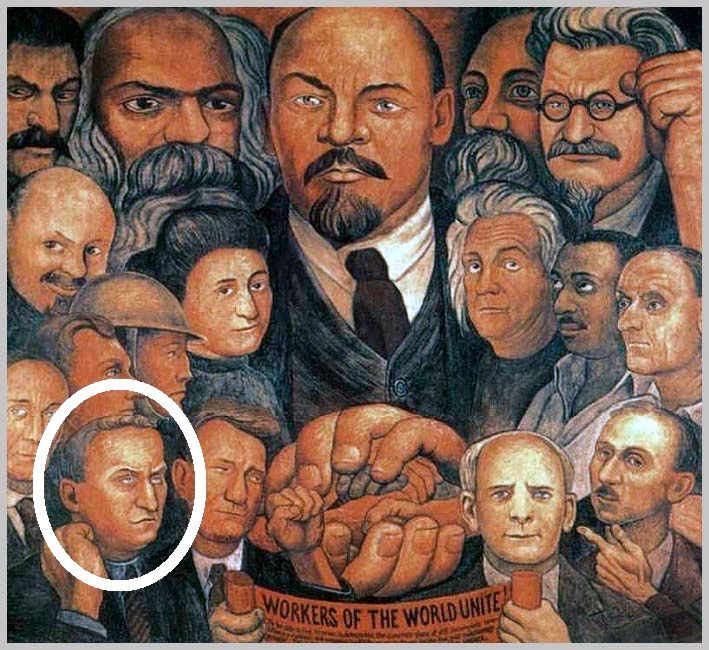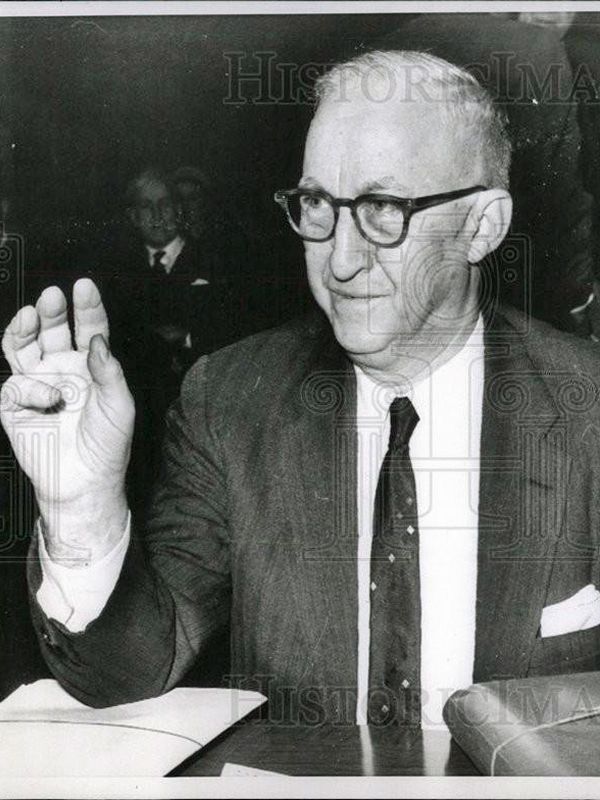He came to the U.S. with his family in 1907. According to Ted Morgan, author of A Covert Life: Jay Lovestone: Communist, Anti-Communist, and Spymaster, "...the family did not know their dates of birth precisely, but they assigned Jacob the date of December 15, 1897." Note in the obituary that follows, there is disagreement as to his date of birth.
Obituary, published in the New York Times, March 9, 1990:
Jay Lovestone, Communist Leader Who Turned Against Party, Dies
By Glenn Fowler
Jay Lovestone, who briefly headed the Communist Party in the United States in the 1920's before becoming a staunch anti-Communist, died in his sleep Wednesday at his home in Manhattan. He was 91 years old. Mr. Lovestone, who once called Stalin a murderer and lived to tell about it, became a colorful and often controversial figure in the American labor movement. He served as the international affairs director of the A.F.L.-C.I.O. before his retirement in 1974.
His confrontation with Stalin occurred in Moscow in 1929 after Stalin had deposed Mr. Lovestone from the leadership of the party in the United States, a post he had held for two years. The taunted Stalin was said to have become livid and promptly terminated the interview. Mr. Lovestone managed to escape from the Soviet Union by way of Danzig [now Gdańsk, Poland] with the help of false identity papers. The incident, which occurred when Mr. Lovestone was 29 years old, ended his comparatively short but spectacular career as a Communist. However, he remained vastly knowledgeable about Communist affairs throughout the world. His friends said he had an extraordinary network of contacts, with whom he kept in close touch, and a remarkable sensitivity for developments in Communist world before they became apparent to others.
Born on Dec. 24, 1898, in Lithuania, then a part of Russia, he was brought to the United States when he was 9, by his father, who had obtained a job as cantor of a New York synagogue. By the time he graduated from City College in 1918 the son was deeply involved in the Socialist and Communist movements, which were then largely subterranean in this country. In 1921 he got his first full-time Communist Party post, as editor of the party's official underground organ, The Communist. He made an enemy of Stalin early on. In 1923, when Stalin, the eventual Soviet ruler, split with Nicolai Bukharin, the powerful head of the Comintern, the Communist International, Mr. Lovestone was a leader in defending Bukharin.
As he moved higher in the American Communist hierarchy, Mr. Lovestone continued to pursue a line basically opposed to Stalin's. The Lovestone argument was that because of special circumstances in the United States, the struggle against capitalism could not be conducted along traditional Marxist-Leninist lines.
Stalin called the leaders of the splintered American communist movement to a meeting in Moscow in July, 1929, where he ordered them "detained" for a year if necessary to work out their differences. Mr. Lovestone, who was then called "the American Stalin" by his followers, cabled to his friends that he was being "forcibly detained" and asked that if word was not had from him in 10 days they should begin to "agitate for his release." However, he managed to flee and return to New York City. An angry Stalin called Mr. Lovestone "a renegade to the cause of communism" and ordered him expelled from Communist ranks. Stalin called Mr. Lovestone's theories "exceptionalism."
Mr. Lovestone and his followers formed what they called the Communist Party of the United States, later becoming the Independent Labor League of America and acquiring the sobriquet "Lovestonites." The group disbanded in 1940, but not before the artist Diego Rivera included a portrait of Mr. Lovestone in one of his murals of the revolutionary spirit in American history. The mural also included Lenin, Trotsky, Stalin and an American soldier, black man, farmer and laborer.
By that time Mr. Lovestone had concluded that the Communist movement, which he once considered the salvation of the working class, was a monstrous totalitarian conspiracy engineered by the Kremlin with the goal of world conquest.
In the early days of World War II, when the Stalin-Hitler pact had given Axis forces free rein in Europe and led orthodox American Communists to espouse strict neutrality, Mr. Lovestone became a leader of the Committee to Defend America, a group that sought to mobilize support for Britain and the other Allies.
In 1943 he was named international affairs director for the International Ladies Garment Workers Union. The following year he became executive secretary of a new group that after the war's end, formed the International Confederation of Free Trade Unions, which was organized to oppose the Communist-dominated World Federation of Trade Unions. In the Congress of Industrial Organizations, and later in the merged A.F.L.-C.I.O., Mr. Lovestone rose in influence and ran the international operation almost as a personal fiefdom granted to him by George Meany, the labor movement's head. The union's International Affairs Department carried on programs to train unionists abroad, particularly in Latin America, through the Institute for Free Labor Development. It also participated in the work of the International Labor Organization, an arm of the United Nations.
He retained his post over the years despite opposition from many labor leaders who regarded him as a doctrinaire anti-Communist. They conceded that he had a valuable network of informers who enabled him to be remarkably prescient about developments in the Communist world. After his retirement he stayed on as a consultant to the labor federation and to the garment workers' union.
Mr. Lovestone, who never married, leaves no immediate survivors.
He came to the U.S. with his family in 1907. According to Ted Morgan, author of A Covert Life: Jay Lovestone: Communist, Anti-Communist, and Spymaster, "...the family did not know their dates of birth precisely, but they assigned Jacob the date of December 15, 1897." Note in the obituary that follows, there is disagreement as to his date of birth.
Obituary, published in the New York Times, March 9, 1990:
Jay Lovestone, Communist Leader Who Turned Against Party, Dies
By Glenn Fowler
Jay Lovestone, who briefly headed the Communist Party in the United States in the 1920's before becoming a staunch anti-Communist, died in his sleep Wednesday at his home in Manhattan. He was 91 years old. Mr. Lovestone, who once called Stalin a murderer and lived to tell about it, became a colorful and often controversial figure in the American labor movement. He served as the international affairs director of the A.F.L.-C.I.O. before his retirement in 1974.
His confrontation with Stalin occurred in Moscow in 1929 after Stalin had deposed Mr. Lovestone from the leadership of the party in the United States, a post he had held for two years. The taunted Stalin was said to have become livid and promptly terminated the interview. Mr. Lovestone managed to escape from the Soviet Union by way of Danzig [now Gdańsk, Poland] with the help of false identity papers. The incident, which occurred when Mr. Lovestone was 29 years old, ended his comparatively short but spectacular career as a Communist. However, he remained vastly knowledgeable about Communist affairs throughout the world. His friends said he had an extraordinary network of contacts, with whom he kept in close touch, and a remarkable sensitivity for developments in Communist world before they became apparent to others.
Born on Dec. 24, 1898, in Lithuania, then a part of Russia, he was brought to the United States when he was 9, by his father, who had obtained a job as cantor of a New York synagogue. By the time he graduated from City College in 1918 the son was deeply involved in the Socialist and Communist movements, which were then largely subterranean in this country. In 1921 he got his first full-time Communist Party post, as editor of the party's official underground organ, The Communist. He made an enemy of Stalin early on. In 1923, when Stalin, the eventual Soviet ruler, split with Nicolai Bukharin, the powerful head of the Comintern, the Communist International, Mr. Lovestone was a leader in defending Bukharin.
As he moved higher in the American Communist hierarchy, Mr. Lovestone continued to pursue a line basically opposed to Stalin's. The Lovestone argument was that because of special circumstances in the United States, the struggle against capitalism could not be conducted along traditional Marxist-Leninist lines.
Stalin called the leaders of the splintered American communist movement to a meeting in Moscow in July, 1929, where he ordered them "detained" for a year if necessary to work out their differences. Mr. Lovestone, who was then called "the American Stalin" by his followers, cabled to his friends that he was being "forcibly detained" and asked that if word was not had from him in 10 days they should begin to "agitate for his release." However, he managed to flee and return to New York City. An angry Stalin called Mr. Lovestone "a renegade to the cause of communism" and ordered him expelled from Communist ranks. Stalin called Mr. Lovestone's theories "exceptionalism."
Mr. Lovestone and his followers formed what they called the Communist Party of the United States, later becoming the Independent Labor League of America and acquiring the sobriquet "Lovestonites." The group disbanded in 1940, but not before the artist Diego Rivera included a portrait of Mr. Lovestone in one of his murals of the revolutionary spirit in American history. The mural also included Lenin, Trotsky, Stalin and an American soldier, black man, farmer and laborer.
By that time Mr. Lovestone had concluded that the Communist movement, which he once considered the salvation of the working class, was a monstrous totalitarian conspiracy engineered by the Kremlin with the goal of world conquest.
In the early days of World War II, when the Stalin-Hitler pact had given Axis forces free rein in Europe and led orthodox American Communists to espouse strict neutrality, Mr. Lovestone became a leader of the Committee to Defend America, a group that sought to mobilize support for Britain and the other Allies.
In 1943 he was named international affairs director for the International Ladies Garment Workers Union. The following year he became executive secretary of a new group that after the war's end, formed the International Confederation of Free Trade Unions, which was organized to oppose the Communist-dominated World Federation of Trade Unions. In the Congress of Industrial Organizations, and later in the merged A.F.L.-C.I.O., Mr. Lovestone rose in influence and ran the international operation almost as a personal fiefdom granted to him by George Meany, the labor movement's head. The union's International Affairs Department carried on programs to train unionists abroad, particularly in Latin America, through the Institute for Free Labor Development. It also participated in the work of the International Labor Organization, an arm of the United Nations.
He retained his post over the years despite opposition from many labor leaders who regarded him as a doctrinaire anti-Communist. They conceded that he had a valuable network of informers who enabled him to be remarkably prescient about developments in the Communist world. After his retirement he stayed on as a consultant to the labor federation and to the garment workers' union.
Mr. Lovestone, who never married, leaves no immediate survivors.
Sponsored by Ancestry
Advertisement
Records on Ancestry
Advertisement





